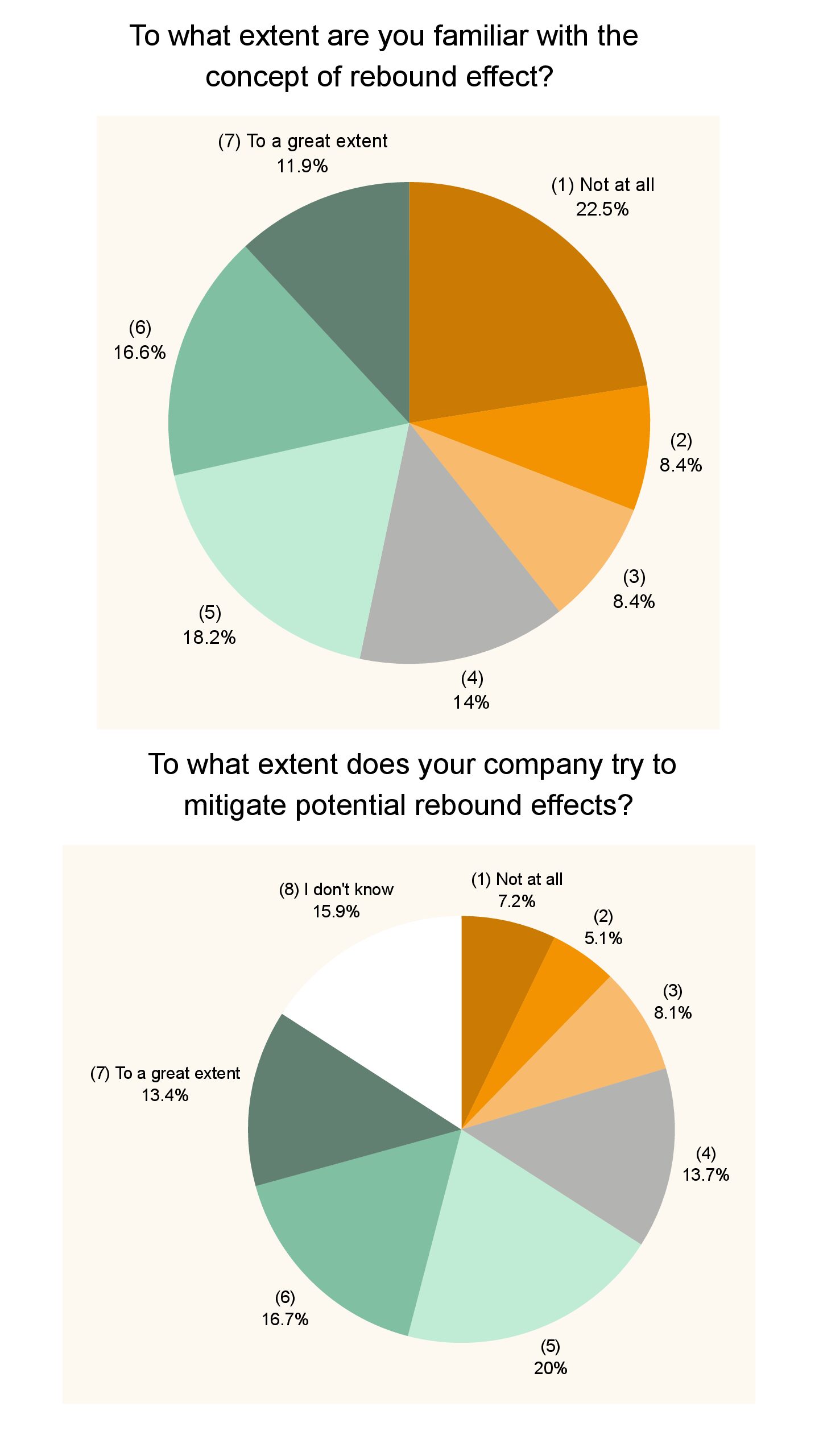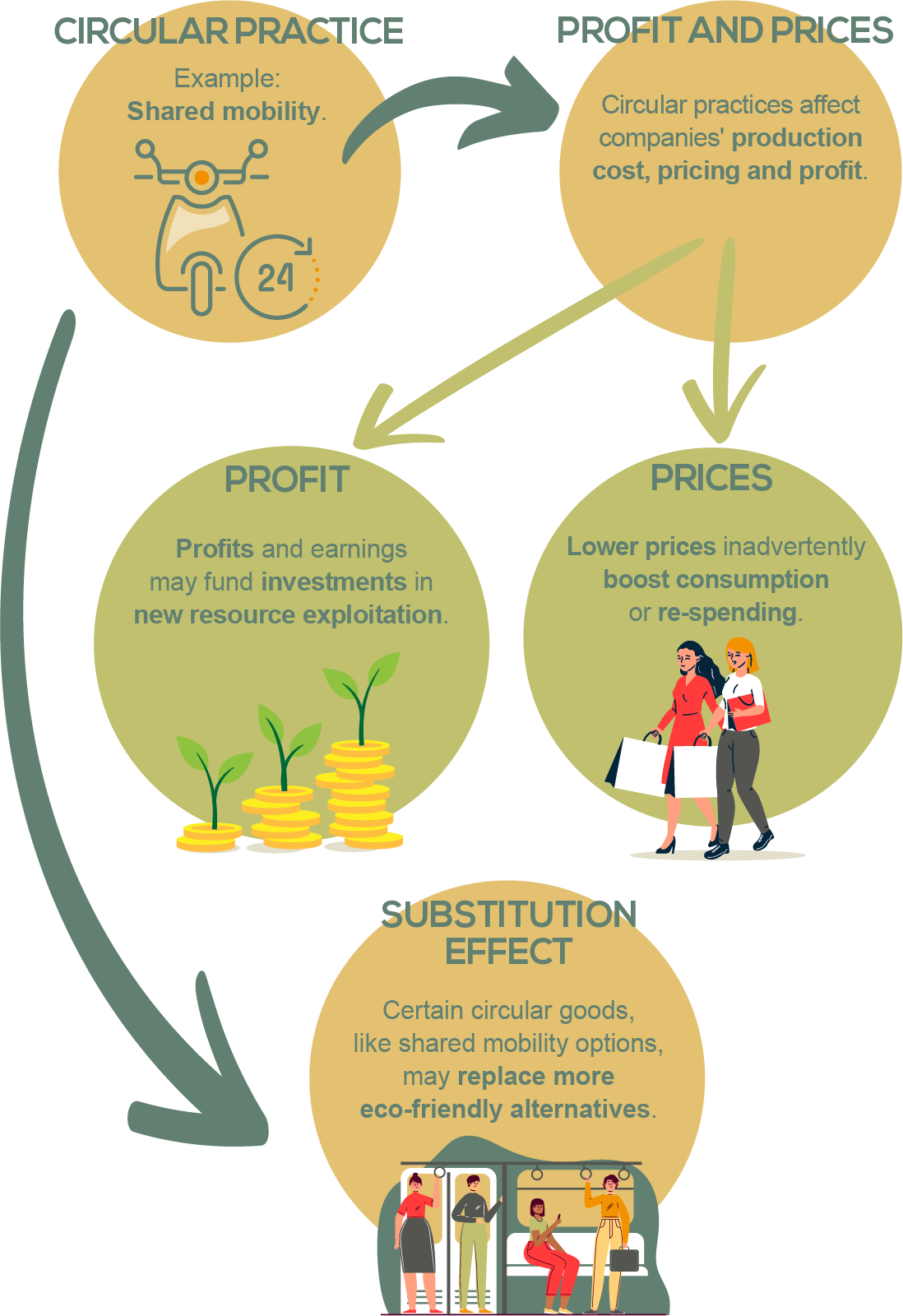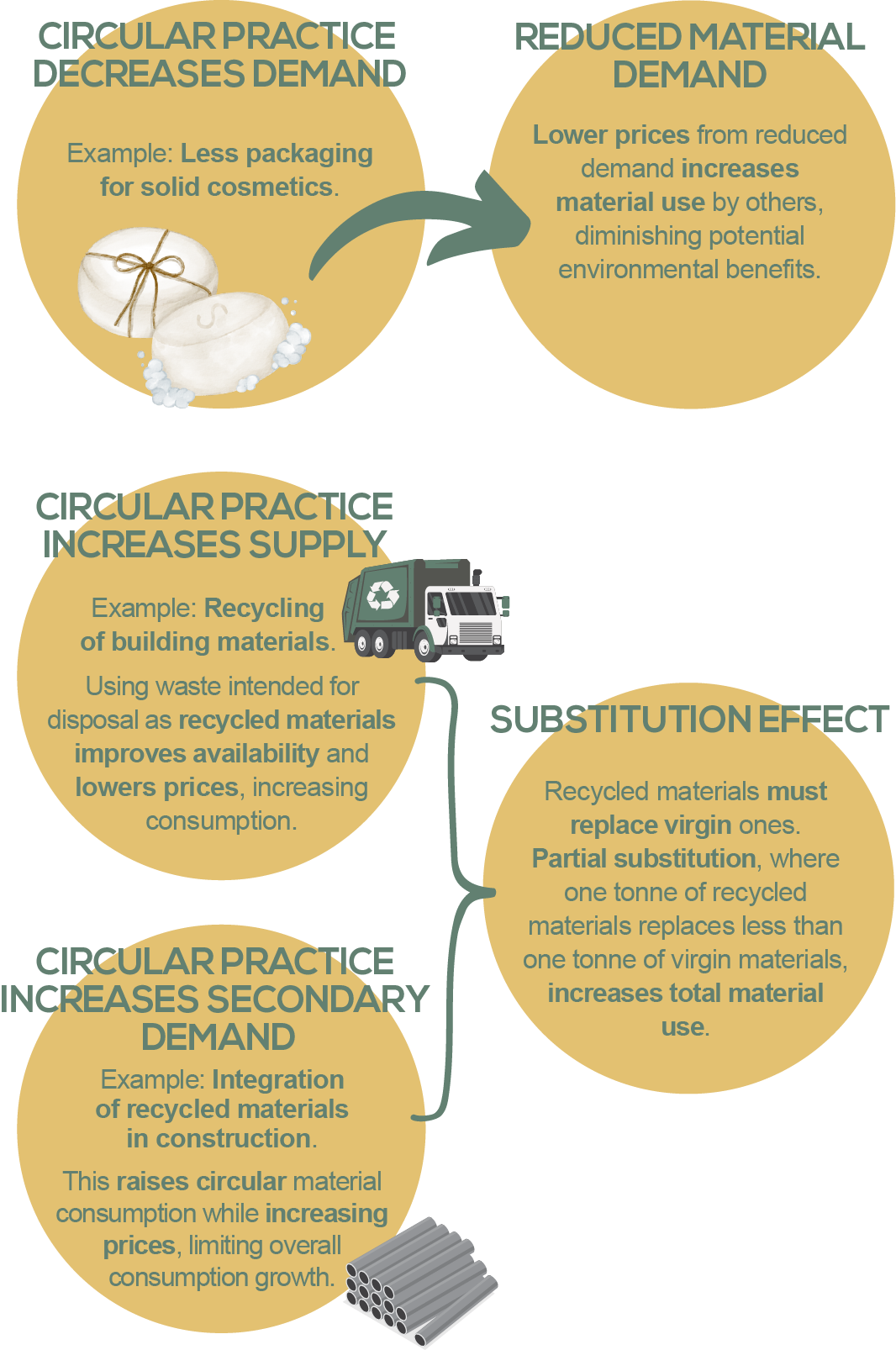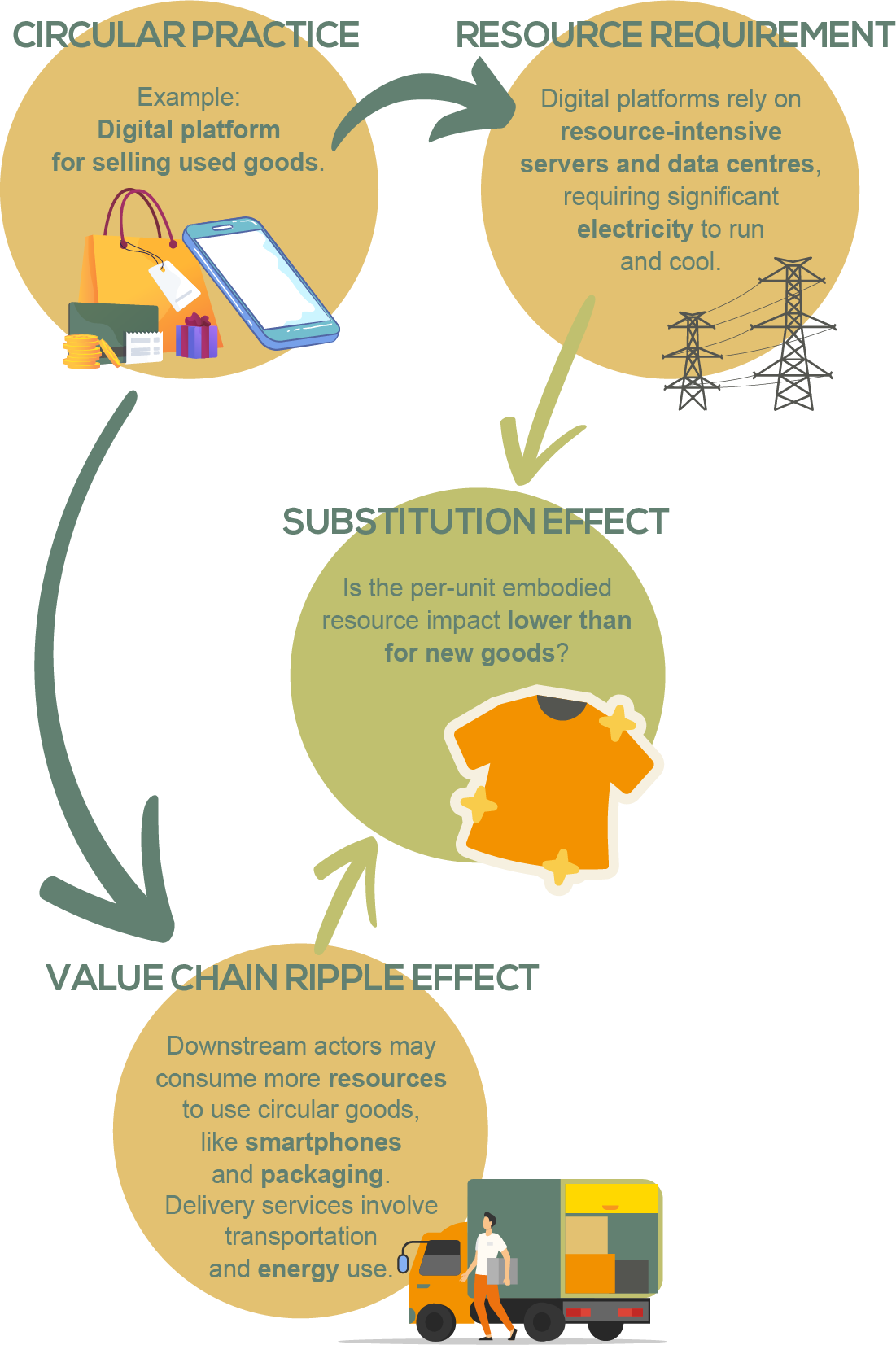Benchmark your knowledge on rebound effects, understand why they matter and explore the key dynamics.
Rebound effects
The rebound effect represents a significant environmental challenge for businesses pursuing sustainability, as it can fundamentally compromise their sustainability goals. For instance, efficiency gains that lower prices can lead to higher overall consumption, cancelling out environmental benefits. The rebound effect's complex dynamics extend far beyond simple pricing considerations, requiring businesses to carefully navigate these multifaceted mechanisms.
Why should businesses care about rebound effects?
By taking action on rebound effects within their control, companies might benefit from:
- Stronger brand reputation and consumer trust through genuine environmental stewardship.
- Higher employee engagement by ensuring sustainability initiatives deliver meaningful environmental impact, reinforcing organisational purpose.
- Sustainability investment protection by safeguarding the Return On Investment (ROI) on environmental initiatives
- Financial and compliance risk mitigation, including carbon taxation, while meeting ambitious sustainability targets.
- Business model resilience assurance by reducing resource dependencies and vulnerabilities
- Market expectation alignment with consumers and Business2Business customers demanding authentic sustainability credentials and condemning greenwashing.
- Ethical concerns regarding the company's responsibility to contribute meaningfully to environmental sustainability and climate goals.
These insights come from a series of consultations and reflections as part of the Circular ReBoundary project (CircEUlar Deliverable D3.2.) and may not be applicable to all organizational contexts. Should you identify additional factors not represented here, we encourage you to contact us at circular.reboundary@cmcc.it for further discussion.

Peers’ perspective on rebound effects.
A recent survey of more than 3,000 employees shows that workers have a mixed understanding of the “rebound effect”- a concept that describes how efficiency improvements can sometimes lead to increased overall resource use. Just over half of respondents (53.3%) reported having limited familiarity with the concept (1–4 on a 7-point scale), while fewer than 12% demonstrated strong knowledge. Approximately 46.7% indicated a moderate to good understanding (5–7).
The study found a clear connection between job responsibilities and awareness: Employees whose roles included sustainability tasks were much more likely to understand rebound effects, with only 4% reporting no familiarity compared to 60% among those without sustainability responsibilities. However, even workers in sustainability-focused positions showed knowledge gaps, suggesting there's room for improvement in educating all employees about how efficiency gains can sometimes lead to unintended environmental consequences.
After being provided with a brief definition of the rebound effect, half of all respondents reported that their company is already taking steps to mitigate rebound effects. Notably, those who indicated they were unaware of any such actions tended to be individuals who were unfamiliar with the concept itself.
Future research should investigate which mitigation strategies are implemented and evaluate their effectiveness.

The rebound dynamics
CMCC’s research, "From (Micro-)Circularity to (Macro-)Mitigation", conducted under the CircEUlar project, identifies key pathways through which circular business practices systematically influence resource use at the broader societal level. These pathways offer valuable insight into the broader impacts of circular models, though they are not exhaustive and do not capture all rebound effects.
Financial aspects and final demand
Adopting circular solutions comes with significant cost considerations, as it may require new expertise, technologies, or capital investment, although the circular practice could also help reduce production costs over the medium term.
It is essential to consider how these changes in costs affect pricing. Will costs or savings be transferred to the consumer? A lower price could drive higher demand, while increased revenues or profits will impact resource consumption depending on their allocation.
Finally, introducing a circular product or service may lead to displacing existing offerings, within your company or across the market, reshaping consumption patterns in unexpected ways. Substitution effects can bring environmental gains, for example, when car-sharing reduces the need for private car ownership. However, not all substitutions are beneficial. For instance, car-sharing might replace more sustainable alternatives like cycling or public transport, ultimately increasing environmental impact.

Material aspects and market dynamics
Circular practices directly affect how materials are used, whether they're in products, virgin materials from extraction, or materials recovered from waste. Since these practices change material usage patterns, they also influence market quantities and prices. Here weexamine the direct impact of circular strategies on material markets, identifying three possible effects.
1. Reduced Material Demand
Companies positioned in the value chain as providers of circular goods and purchasers of materials can adopt circular practices like efficient design, in-house reuse, and sharing, which can reduce material requirements. When multiple companies implement such practices, this creates reduced demand at the market level, causing material prices to drop. Lower prices make materials cheaper for everyone, potentially encouraging other businesses to use more materials than they otherwise would have. This price-driven increase in consumption partially offsets the original material savings from circular practices, creating a rebound effect where total material consumption decreases less than expected. Despite this rebound, overall material consumption still decreases compared to the scenario without circular practices, but the environmental benefits are smaller than initially anticipated.
2. Increased Material Supply
Companies positioned as suppliers of secondary goods implement circular practices by providing recycled materials or reused products to the market. When these materials and goods, which would otherwise be discarded, are reintroduced into the marketplace, they increase the total supply of available materials. This increased supply drives prices down, making materials more affordable across the market, which under normal conditions leads to higher overall consumption and potentially increases total material use rather than reducing it. The key to avoiding this increase in resource use lies in achieving a strong substitution effect, where recycled materials replace virgin materials rather than simply adding to the total available supply.
3. Increased Secondary Material Demand
Companies integrating recycled materials or refurbished goods into their production processes contribute to greater demand for circular resources. This demand can raise prices, further incentivising the collection and processing of waste materials and limiting the increase in consumption. What is essential, again, is whether this increased consumption of circular goods replaces the demand for non-circular goods, the substitution effect.
4. Substitution effect
For circular practices to truly help the environment, recycled and reused materials must replace new (virgin) materials and products. Whether this happens depends on how well circular options perform in terms of price and quality. In incomplete substitution scenarios, increased demand for circular inputs doesn't fully offset the reduction in demand for non-circular inputs, leading to higher total material consumption. This often occurs in down-cycling situations where recycled materials have lower quality or functionality than virgin alternatives. Conversely, over-complete substitution occurs when one circular input can replace multiple virgin inputs, potentially, such as sharing systems where one shared item replaces numerous individual purchases. Companies can maximise environmental benefits by designing circular solutions that achieve over-complete substitution wherever possible.

Resource consumption of circular practices
Implementing circular practices requires businesses to account for resource requirements and broader ripple effects across their value chains. At the company level, circular practices require some additional specific material and energy resources. For example, producing thinner packaging may require new machinery, sharing systems need digital infrastructure, and recycling involves energy consumption and transportation costs.
In particular, the value chain ripple effect includes how customers and downstream partners require resources to access or consume circular products or services. For instance, if customers spend additional time and resources accessing circular options (like driving further to zero-waste stores), these factors can offset intended resource savings.
The key for companies is to ensure that circular products deliver a lower per-unit resource impact than non-circular products when all resources are considered. This requires revisiting the issue of substitution, that is, understanding whether circular goods can substitute for conventional products.
In the next stage of your learning journey ACTIONS, explore concrete actions businesses can adopt to curb unintended resource use and manage rebound effects.

References and other resources
Survey data source
The employee survey consisted of 3,391 employees working in the mobility, building, and manufacturing, across five European countries (without representative quotas).
- Pacheco, I., Wagner, B., Wang, X., van der Werff, E., & Steg, L. (2025). Data set of employee beliefs, perceptions, and behaviours regarding circularity [Data set]. Zenodo. https://doi.org/10.5281/zenodo.16909830
References
- Joltreau, E., Verdolini, E., & Cattaneo, C. (2025). From (Micro-) Circularity To (Macro-) Mitigation: A Framework Bridging Firm-Level Circularity, Rebound Effects and Policies. Zenodo. https://doi.org/10.5281/zenodo.16982589
- Joltreau, E., Cattaneo, C., & Verdolini, E. (2025). Online tool containing information on available circular approaches in the provision of goods and services - Circular ReBoundary project (CircEUlar Deliverable 3.2)
- Joltreau, E., Pacheco, I. (in progress) Beyond Good Intentions: Measuring Employee Understanding of Rebound Effects and Corporate Rebound Mitigation Actions
To go further: the REBOUNDLESS project
You have now explored rebound effects related to three specific channels. However, rebound effects can occur across a broader range of contexts. To deepen your understanding, you can consult findings from the EU-funded REBOUNDLESS project led by the Technical University of Denmark. In particular, the REBOUNDLESS Dashboard maps hundreds of documented rebound effect cases, drawing from multiple scientific studies. Through this tool, you can examine rebound effects across different sustainability strategies, social need areas, knowledge domains, and more. The dashboard also provides insights into the magnitude and range of various rebound effects.